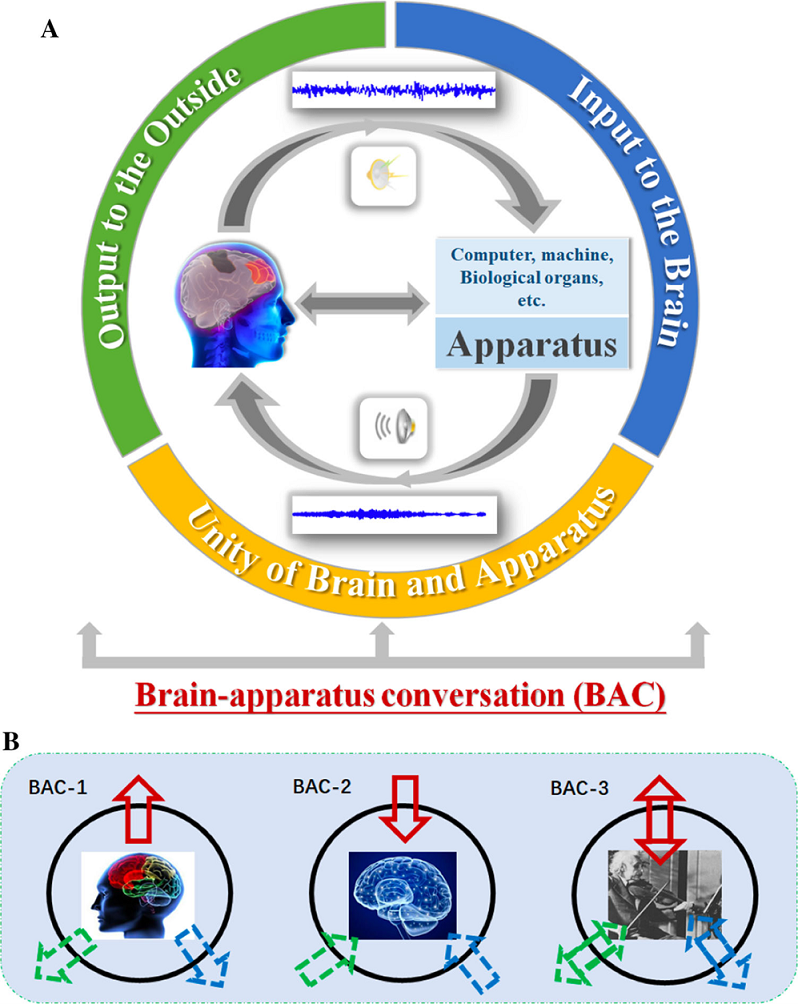

The brain is the most important organ of the human body, and the conversations between the brain and an apparatus can not only reveal a normally functioning or a dysfunctional brain but also can modulate the brain. Here, the apparatus may be a nonbiological instrument, such as a computer, and the consequent brain–computer interface is now a very popular research area with various applications. The apparatus may also be a biological organ or system, such as the gut and muscle, and their efficient conversations with the brain are vital for a healthy life. Are there any common bases that bind these different scenarios? Here, we propose a new comprehensive cross area: Bacomics, which comes from brain–apparatus conversations (BAC) + omics.
We take Bacomics to cover at least three situations: (1) The brain is normal, but the conversation channel is disabled, as in amyotrophic lateral sclerosis. The task is to reconstruct or open up new channels to reactivate the brain function. (2) The brain is in disorder, such as in Parkinson’s disease, and the work is to utilize existing or open up new channels to intervene, repair and modulate the brain by medications or stimulation. (3) Both the brain and channels are in order, and the goal is to enhance coordinated development between the brain and apparatus. In this paper, we elaborate the connotation of BAC into three aspects according to the information flow: the issue of output to the outside (BAC-1), the issue of input to the brain (BAC-2) and the issue of unity of brain and apparatus (BAC-3).
More importantly, there are no less than five principles that may be taken as the cornerstones of Bacomics, such as feedforward and feedback control, brain plasticity, harmony, the unity of opposites and systems principles. Clearly, Bacomics integrates these seemingly disparate domains, but more importantly, opens a much wider door for the research and development of the brain, and the principles further provide the general framework in which to realize or optimize these various conversations.
大脑是人体最重要的单元,大脑与器物(apparatus)之间的交互不仅可以揭示大脑功能正常与否,同时还可以调节大脑。此处的“器物”,可以是一种非生物器械,如计算机,相应的脑(计算)机接口(Braincomputerinterface-BCI)是当前非常热门的研究领域,也有了多种应用。但“器物”也可以是一个生物器官或系统,如肠道、肌肉、心脏、外周神经等,它们与大脑间的有效交流对健康生活至关重要。那么,这些看似不同的交互场景是否有一些共同的基础?在本文中,我们提出建立一个新的交叉学科:脑器交互学,其英文由脑-器交互(brainapparatusconversations)的缩写BAC和组学(omics)结合而成(Bacomics)。
我们认为脑器交互学的研究内容至少涵盖三个方面:(1)大脑是正常的,但交互通道受损,如肌萎缩性脊髓侧索硬化症,针对这类情况,BAC的任务就是重建或创建新的传输通道,以重新焕发大脑的功能;(2)大脑功能已紊乱,如帕金森症,此时,BAC的目标便是借助现有的通道或开辟新的通道,如利用药物或外界刺激对大脑进行干预、修复和调节;(3)大脑和通道都是正常的,BAC的目的是提升大脑和器官之间的协调性,以进一步提升其身心健康水平和脑智能力。当然,我们也可以根据BAC中的信息流的情况,对脑器交互学的内涵进行如下的分类:大脑向外界输出信息的问题(BAC-1)、外界向大脑输入信息的问题(BAC-2),以及基于信息双向流动的脑器合一问题(BAC-3)。
文章后面的内容按这种分类来进行介绍。此外,我们还建议了5个原理来作为脑器交互学的基础,它们是反馈与前馈调节原理、宇宙和谐原理、系统性原理、神经系统的可塑性原理和对立统一原理。显然,脑器交互学不仅仅是整合了之前认为不相关的多个领域,而且为大脑的研究、开发和保护打开了一扇新的大门,展示了更为广阔的空间,相关的原理则为BAC的各种实现及其优化提供了基本的理论框架,其面临的挑战和孕育的机遇则期待有更多的参。
![]() 2010年11月 尧德中 北京 从脑机接口到脑器交互.pdf
2010年11月 尧德中 北京 从脑机接口到脑器交互.pdf
![]() 2019年08月 尧德中 西安 脑器交互学及应用 (Bacomics and its applications) final.pdf
2019年08月 尧德中 西安 脑器交互学及应用 (Bacomics and its applications) final.pdf
![]() 【链接】公开课演讲实录 | 尧德中:脑器交互学,一个发展中的新学科
【链接】公开课演讲实录 | 尧德中:脑器交互学,一个发展中的新学科
![]() 公开课演讲实录 _ 尧德中:脑器交互学,一个发展中的新学科.pdf
公开课演讲实录 _ 尧德中:脑器交互学,一个发展中的新学科.pdf
![]() Editor Board of “Brain-Apparatus Communication-A journal of Bacomics”.
Editor Board of “Brain-Apparatus Communication-A journal of Bacomics”.
本页面的文字允许在知识共享 署名-相同方式共享 3.0协议 (https://zh.wikipedia.org/wiki/Wikipedia:CC-BY-SA-3.0协议文本)
和GNU自由文档许可证 (https://zh.wikipedia.org/wiki/Wikipedia:GNU自由文档许可证文本)下修改和再使用。